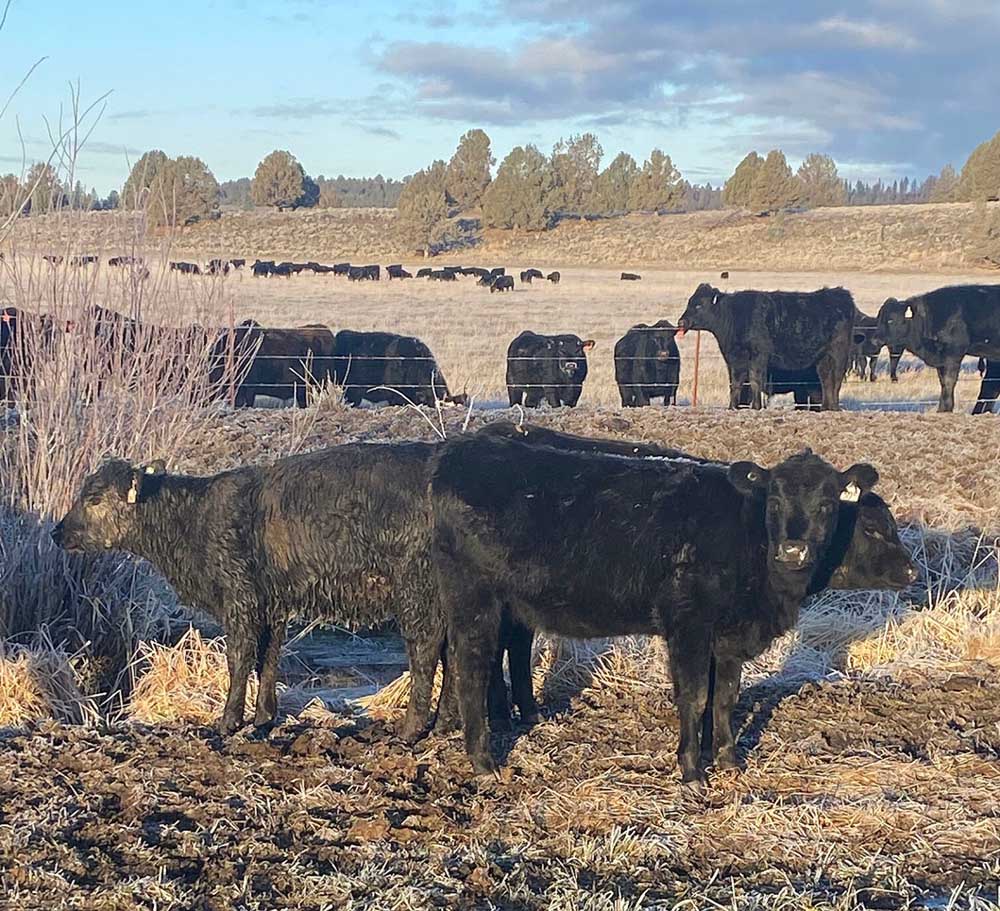Wolves kill more calves in S. Oregon
Published 11:19 am Monday, November 29, 2021

- These black Angus calves on the Wilks Ranch near Bly, Ore., have been attacked by wolves. Five calves on the ranch were confirmed as wolf kills in the last month by Oregon Department of Fish and Wildlife officials.
When Amy Fitzpatrick went out to help with a morning feed for cattle on Oct. 29, her day was quickly ruined by what she saw.
Three yearling steers, each weighing about 650 pounds, were dead in the field.
“You knew right away it was wolves,” Fitzpatrick said. “Wolf tracks were everywhere.
“It made me sick to my stomach, a hopeless feeling,” added Fitzpatrick whose father, Ron Anderson, owns the Butte Falls, Ore., area ranch and livestock. “You’re going through the cattle every day and they’re healthy, and then to see them lying there dead. It’s heartbreaking.”
Oregon Department of Fish and Wildlife officials confirmed the three steers as wolf kills by the Rogue Pack.
Two days later on the Anderson ranch, another 650-pound steer was confirmed as a wolf kill.
At about the same time, but a couple hundred miles to the east, a different group of wolves negatively impacted livestock on the Wilks Ranch outside Bly, Ore. A calf was confirmed as a wolf kill on Oct. 31, two calves were confirmed as wolf kills on Nov. 5, another calf on Nov. 9 and a fifth calf on Nov. 15. Two more calves during that period were listed as probable wolf kills. One of the calves was not found dead, but was injured so badly, it had to be euthanized.
Depending on weight and sex, these animals are valued between $1,500 and $2,500.
“It’s so disgusting to have to put up with something like this,” Anderson said. “It’s our livelihood. We just can’t afford to be losing cattle every year to these predators, and we don’t know what they’re doing to the deer and elk populations. You use to see deer and elk a lot out in the mountains, but now you just don’t see them.”
Anderson said he’s lost a few calves or yearlings each of the past few years to wolves, the first wolf-cattle conflict coming four years ago. He explained he runs cattle on Forest Service and Bureau of Land Management grazing permits and when those animals return home, there’s always a few missing, especially calves. They could be missing for several reasons, one being wolves.
Both the Anderson and Wilks ranches have used non-lethal methods to try and discourage wolves. Those methods included noise, alarm and scare devices, disposing of bone piles, bright lights, guard dogs and human presence. Anderson said a neighboring ranch put up fence fladry, but it didn’t deter the wolves so he didn’t use it.
“According to officials, we’re doing everything we can to check off all the boxes in order to appease environmentalists and ODFW so we’ll be able to take wolves out legally,” said Steve Hartzell, manager of the Wilks Ranch.
Hartzell said he knew wolves were in the area because a collared male wolf and a smaller female wolf were seen in a pasture during a mid-September afternoon. He said he believes the male wolf was collared in Lassen County, California. The confirmed livestock kills on the Wilks Ranch have been tagged to the Lassen wolf.
Veril Nelson, the Western Oregon representative on the Oregon Cattlemen’s Association’s wolf committee, emphasized that it is important for ranchers to report conflicts and livestock loss due to wolves.
“It takes four qualified kills in a six-month period in order to justify going to lethal take of wolves,” said Nelson who owns and operates a cattle ranch in the foothills of the Cascade Mountains east of Sutherlin, Oregon. “All ranchers in areas where there is a wolf presence need to be on top of the situation. The sooner we get to four qualified kills, the sooner the bad actors (wolves) can be removed.”
It is a complex rule that includes the following condition: “Confirms a total of at least 4 qualifying incidents of depredation of livestock within the previous 6 months by the same wolf or wolves.”
“It’s a complicated situation,” Nelson said. “The wolf issue is highly political. There’s a lot of pressure by environmentalists and wolf advocates not to kill wolves. There’s always a threat of a lawsuit. ODFW is reluctant to remove wolves. That’s a situation that doesn’t favor ranchers.”
Nelson said there are wolves that don’t prey on livestock and they should be left alone. But he said wolves that prey on livestock pass that trait onto their pups and those are the wolves and packs that need to be removed. He added that a study has shown that partial removal – one or two wolves from a pack – only deters the other pack members for a week or two and then they’re back pursuing and killing livestock.
Anderson agreed that killing livestock has been bred into the Rogue Pack.
“There’s only one way to solve these conflicts,” he said. “The Rogue Pack needs to be eliminated. Those wolves are notorious for killing livestock. It’s been bred into this pack.”
Hartzell agreed.
“In my opinion, the only way to solve this is to take out the killers,” he said of wolves. “Once wolves start killing cattle, they don’t stop.
“We’re right on the edge of the Bootleg Fire, there were big game losses in that fire, deer are leaving because wolves are here and I don’t think the game is out there to support the wolves,” he added. “The cattle are easy to kill for the wolves.”









